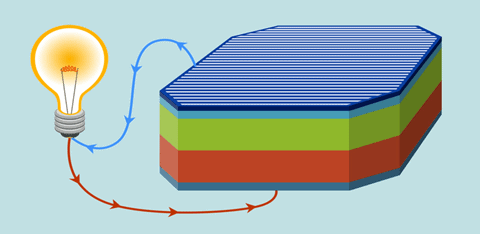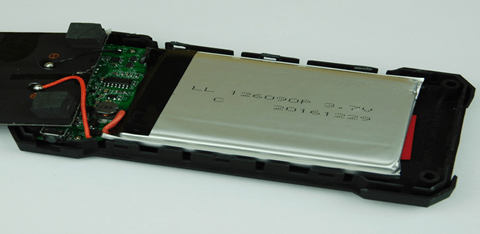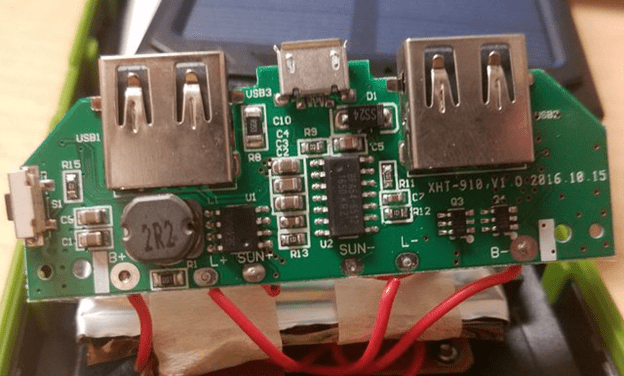How a Solar Battery Charger Works
Page Contents
Written by qualified solar engineer Aniket. Last updated:
A solar battery charger works by using photons in the sunlight to make electrons in the solar cells flow in a circuit, thus causing current and charging a battery in the solar power bank. By using direct sunlight as its source of energy, a solar battery charger proves to be one of the best solar gadgets, as it charges devices while being away from the grid.
At a basic level, solar battery chargers work like any solar power system, but are much more compact and meant for smaller devices such as mobile phones and tablets. An important difference from typical solar systems is that solar battery chargers are entirely DC devices, meaning there is no mechanism to give AC power output.
Components and Their Workings
A solar powered phone charger is a simple electronic appliance. It consists of a solar cell/panel that generates the energy required. A battery stores this energy and some supporting electronic hardware to make this process safe, optimal, and efficient.

Let’s have a more detailed look at each of these components and how they work:
Solar Panel
Today, solar energy powers many appliances of different sizes, from solar garden lights to entire home systems. When it comes to portable chargers, the solar panel is the power generating component of the chargers and the most distinguishing feature from standard battery chargers. As the name suggests, they harness solar energy and convert it into electrical energy.
Currently, the best solar cell material in the market is silicon. Today, the best solar cells in the market are also commercially feasible are monocrystalline cells, which are the most preferred choice for portable solar chargers.
This is done when photons (particles of light) in sunlight strike the solar cells’ surface and cause electrons to break off from their orbits. This phenomenon is called the photoelectric effect. Electricity is the flow of electrons through a circuit, whether it is power flowing through car battery chargers or a power station.
To amplify this effect, two regions are created in the solar cell – one with excess electrons and one deficient of electrons. The electrons cannot pass from one region to another due to a closed border known as the ‘depletion layer’. They must travel in an external circuit to reach the other layer, which is the other end of the cell.

Working of a Solar Cell (Source – PBS)
The above image is a simple representation of how the cell works. The green region is the n-region (excess electrons), and red is the p-region (electron-deficient). The more photons that strike the surface, the higher solar energy is utilized, meaning more power generation. Hence, phone chargers work best in direct sunlight.
In the case of a solar battery charger, this external circuit charges the battery inside, bringing us to our next component in the list.
Rechargeable Battery
Some solar chargers work without a built-in battery, but they can be used only during hours of sunlight. Thus, a battery is essential if you want to use the charger at any hour of the day. Batteries are chemical devices that can store energy and supply it whenever required.
Portable solar chargers usually have a lithium-ion battery in them, which allows to pack more battery life per unit volume – one of the major benefits of solar battery chargers. These batteries are usually rated at 3.6 V, while regular cell phone chargers work at 5 V.
Good quality chargers can have batteries with a capacity up to 20,000 mAh, meaning a full charge can carry enough energy to charge several smartphones. For a large battery, however, it will take longer to charge from solar. They also have a longer battery life, with thousands of charging-discharging cycles.
Voltage is the electric potential difference between two points, like water stored at two points of different elevations. It will always flow from the higher potential to the lower potential.
Hence, the solar panel needs to be at a slightly higher potential than the battery to charge from the sun. Batteries of portable solar chargers usually come at around 3.6 V; hence the solar panel should be around the same range – not lower than that, but not too high to avoid damage.
The image below shows the inside of a portable solar battery charger. The first thing we see is the large slab of the rechargeable battery inside. In the picture here, the battery (silver) occupies most of the volume and weight inside the charger casing, similar to standard battery chargers.
On the left side, a portion of the solar panel can be seen. Two wires connect the positive and negative to the printed circuit board (PCB), which then connects to the battery.

Technically, solar panels can charge your battery directly. However, for optimal and safe battery charging, some electronics need to be in place too. For a small device like this, a small PCB is sufficient. Let’s have a look at what it does.
PCB
PCB stands for ‘Printed Circuit Board’, which as the name suggests, is a board that connects several small electronic items and mechanically supports them electronically. These include resistors, diodes, LEDs, etc. A solar phone charger works flawlessly thanks to this small, flat piece of technology.
Following is the image of a PCB from a solar powered phone charger. There is quite a bit of circuitry, and hence complexity involved in how solar battery chargers work. But from a higher-level perspective, it is simple to understand how it works.

PCB inside a solar battery charger (Source – Steemit)
The wires are soldered to the points that say B, L, and SUN, which stand for battery, LED, and solar, with the positive and negative markings. Poor quality chargers might have weakly soldered wires, making physical shocks a serious problem.
Almost every charger will have one or more LEDs to indicate either a dead battery, full charge, or battery charging in progress.
The two large metal pieces on the top are USB ports, which will connect the charging wire for your device. In the center, a micro USB port can be seen. Thanks to this, you can charge from the sun and another electrical source – your wall unit at home, which is a handy feature. Your regular phone chargers work well in this case. It is also faster with a wall unit to fully charge the battery.
The remaining circuitry includes a boost converter, which steps up the 3.6 V to 5 V, since our phones or tablets have batteries rated at 5 V. As stated before, solar chargers work perfectly with standard cell phone chargers. Some components also protect the battery from possible surge currents.
Should You Buy a Solar Charger?
With lower cost and reliable brands, solar chargers are rapidly gaining popularity. The best solar chargers can pack more battery life, have higher efficiency cells, and a more durable casing. We have an excellent guide to using a solar charger that you can check out.
Unlike bulky systems such as battery chargers for cars, solar powered portable chargers are easy to carry even in a pocket. They are an extremely useful device for anyone who loves the outdoors and hates a phone with a dead battery.
We hope you liked this article. Please rate it or leave us a comment.
Average rating 5 / 5. Vote count: 3
No votes so far! Be the first to rate this post.





